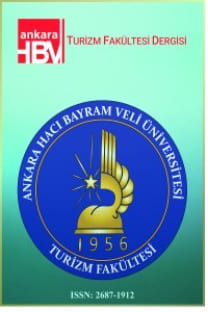İnsan Kaynakları Yönetiminde Yeni Dönem: Yetenek Yönetimi
İnsan kaynakları yönetimi, yetenek yönetimi, stratejik yetenek yönetimi, yetenek yönetimi süreci
THE NEW ERA IN HUMAN RESOURCE MANAGEMENT: TALENT MANAGEMENT
Human resource management, talent management, strategic talent management, talent management process,
___
- ALTUNTUĞ, N. (2009), “Rekabet Üstünlüğünün Sürdürülmesinde Ye- teneklerin Rolü”, Süleyman Demirel Üniversitesi,İ.İ.B.F.Dergisi, Cilt.14, Sayı.3, s.445-460.
- ASTON, C., & MORTON, L. (2005), “Managing talent for competitive advantage”, Strategic HR Review, 4(5), pp.28–31.
- BARNEY, J. B., HESTERLY, W.S. (2008), Strategic Management and Competitive Advantage, 2nd Ed., Pearson Prentice Hill, New Jersey.
- BAYMUR, F. (2004), Genel Psikoloji, 14. Baskı, İnkılap Yayınları, İs- tanbul.
- BERGER, A. L. (2005), “Yetenek Yönetimi”, Executive Excellence, Yıl:8, Sayı:95, 2005.
- BERSIN, J. (2006), “Talent Mangement: What is it? Why now”, May. Çevrimiçi: http://www.bf.umich.edu/docs/KeyReferenceArticles.pdf, Erişim: 21 Ağustos 2010.
- BLASS, E.; KNIGHTS, A.; ORBEA, A. (2006), “Developing future leaders: The contribution oftalent management”, Ashridge Business School, presented at Fifth International Annual Conference on Leadership.
- BUCKINGHAM, M.; VOSBURGH, R.M. (2001), “The 21st century human resources function: It's the talent, stupid ,” Human Resource Planning, 24(4), 2001, pp.17-23.
- BUDAK, G.(2008), Yetkinliğe Dayalı İnsan Kaynakları Yönetimi, 1.Baskı, Barış Yayınları – Fakülte Kitapevi, İzmir.
- CAPELLI, P. (2008), “Talent Mangement fort he Twenty-First Century”, Harvard Business Review, March, pp.74-81.
- CHELOHA, R.; SWAIN, J. (2005), “Talent management system key to effective succession planning”, Canadian HR Reporter, 18(17), pp.5−7.
- COLLINGS, D.G.; MELLAHI, K. (2009),”Strategic Talent Management: A Review and Research”, Human Resource Management Review, 19, pp.304-313.
- CREELMAN, D, (2004, September), “Return on investment in talent management: Measures you can put to work right now”, Human Capital Institute, 2121 K Street, N.W., Suite 800, Washington, DC 20037 USA.
- ÇIRPAN, H. ve ŞEN, A.,( 2009),, “İşletmelerde Yenilikçiliği Geliştirme- de Etkili Bir Araç: Yetenek Yönetimi”, Çerçeve Dergisi, MÜSİAD, Eylül, s.110-116.
- DOĞAN, S.; DEMİRAL, Ö. (2008), “İnsan Kaynakları Yönetiminde Çalı- şanların Kendilerine Doğru Yolculuk Yöntemi: Yetenek Yönetimi”, yal Bilimler Dergisi, 17(3), s.145-166. Ç.Ü. Sos
- DUTTAGUPTA, R. (2005), “Identifying and managing your assets: Talent management”, Intellectual Asset Management Magazine, Çevrimi- çi: http://www.buildingipvalue.com/ 05_SF/374_378.htm, Erişim Tarihi:17 Temmuz 2010.
- DÜREN, Z. (2000), 2000’li Yıllarda Yönetim, Birinci Baskı, Alfa Yayın- ları, İstanbul.
- FORMAN, C. D. (2006), “Talent Metrics”, Leadership Excellence, 23(1), pp.6-7.
- FENWİCK,T., SEVİLE,E., BRUNSDON, D. (2009), “Reducing The Impact of Organisational Silos On Resilience”, Resilient Organisations Research Report (1), Resilient Organisations,March, pp.1-25.
- GALAGAN, P. (2009), , “The New Face of Talent Mangement”, American Society for Training & Develeopment ( ASTD), Whitepaper, Publication http://www.astd.org/NR/rdonlyres/AC467C24-98B2-4613-8A95- 1086C7E3044D/0/010917 TalentMgmtWP5.pdf, Erişim Tarihi: 26 Ağustos 2010. Alexandria VA,pp, 1-18, Çevrimiçi
- GREGOIRE, M. (2006), “Consistently Acquiring and Retaining Top Talent”, Workforce Management, 85(19), p. 6-6.
- GUTHRİDGE, M.; KOMM, A. B.; LAWSON, E. (2006), “The People Problem In Talent Management”, The McKinsey Quarterly, Number 2; Çev- rimiçi: management.pdf, Erişim: 21 Ağustos 2010.
- HUGHES, J.C.; ROG, E. (2008) “Talent Management: A strategy for improving employee recruitment, retention and engagement within hospitality organizations”, International Journal of Contemporary Hospitality Management, 20(7), pp.743-757.
- ILES, P.; CHUAI, X.; PREECE, D. (2010), “Talent Management and HRMin Multinational Companies in Beijing: Definitions, differences and drivers”, Journal of World Business, 45, pp.179-189.
- ISR (2006), “How To Retain & Motivate Your Talent”, Results of ISR’s Asia Pacific Talent Survey, White Paper, Çevrimiçi: www.isrinsight.com, (Erişim: 26.08.2010).
- LAFF, M. (2006), “Talent Management From Hire To Retire”, T+D, November, 60(11), pp.42-48.
- LEWIS, R.E.; HECKMAN, R.J. (2006), “Talent Mangement: A Critical Review”, Human Resource Mangement Review, 16, pp.139-154.
- MCCAULEY, C.; WAKEFIELD, M. (2006), “Talent Management in the 21st Century: Help Your Company Find, Develop And Keep its Strongest Workers”, The Journal For Quality & Participation, Winter, 29(4), pp.4-7.
- MEİSİNGER, S. (2006), “Talent Management in a Knowledge-Based Economy”, HR Magazine, May, 51(5), p.10-10.
- MORAN, M. (2005), “Talent management-Not just another trendy human http://www.cpiworld.com/en/articles/printview.asp?55 retrieved September, 2007. resources term”
- MORTON, L. (2005), Talent Management Value Imperatives: Strategies for Successful Execution, Research Report R-1360-05-RR, Conference Board.
- MUCHA, T. R. (2004), “The Art And Science of Talent Management”, Organization Development Journal, Winter, 22 (4), pp.96-100.
- ÖZGELDİ, M. (2002), “İnsan Kaynakları Anlayışı ve Stratejik İnsan Kaynakları Yönetimi”, Maltepe Üniversitesi İİBF Dergisi, S. 2., s. 17-32.
- PETERS, T. (2006), “Leaders As Talent Fanatics”, Leadership Excellence, November, 23 (11), pp. 12-13.
- PRAHALAD, C.K.; HAMEL, G., (1990), “The Core Competence of the Corporation”, Harvard Business Review, 68 (3), May-June, pp.79-91.
- REDFORD, K. (2005), “Shedding light on talent tactics”, Personnel Today, September, pp.20-22.
- SCHWEYER, A. (2004), “Are you managing your company's talent? An interview with HR-IT consultant and author Allan Schweyer”, Retrieved November showArticle.jhtml?articleId=18100229 from http://www.optimizemag.com/ article/
- SELZNİCK, P.(1984), Leadership in Administration, University of California Press, Berkeley.
- SOCPO (2005), “Talent management—The capacity to make a difference”, The Society for Chief Personnel Officers/Veredus, London
- STEWART, J. (2008), “Developing Through Talent Management”, SSDA Catalyst, 6., pp.1-14.
- STEWART, T.A. (1997), Entelektüel Sermaye, (Çev. Nurettin Elhüseyni), MESS Yayın No:258, İstanbu. TÜRK DİL KURUMU, http://www.tdkterim.gov.tr. Erişim: 17 Temmuz 2010. Büyük Türkçe Sözlük, Çevrimiçi
- ULRICH, D. (1997), Human Resource Champions: The Next Ajanda For Adding Value and Delivering Results, Harvard Business School Pres, Boston, Massachusetts.
- WELLINS, R.; SCHWEYER, A. (2008), Talent Management in Motion: Keeping Up with an Evolving Workforce, A Human Capital Institute/DDI Research /pdf/talentmanagementinmotionkeepingupwithan evolvingworkforce_mis_ddi.pdf, Erişim: 22 Temmuz 2010.
- ISSN: 2687-1912
- Yayın Aralığı: Yılda 2 Sayı
- Başlangıç: 1998
- Yayıncı: Ankara Hacı Bayram Veli Üniversitesi
Kur Riskinden Korunmada Range Forward Kullanımı
Sezer KORKMAZ, Saadet Pınar TEMİZKAN, Rahman TEMİZKAN
İnsan Kaynakları Yönetiminde Yeni Dönem: Yetenek Yönetimi
Çocuklarda Vergi Bilinci Oluşturmaya Yönelik internet Sayfası Tasarımı
Otel Endüstrisinde Yeni Bir Trend: Dizayn Oteller
Cennet Göloğlu DEMİR, Şaban ÇETİN
Azize Tunç HUSSEIN, Duran CANKÜL
Türkiye'de Tarımsal Kredi Uygulamaları
Reyhan TAŞKIRAN, Haşim ÖZÜDOĞRU
